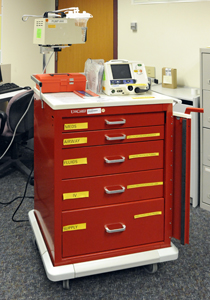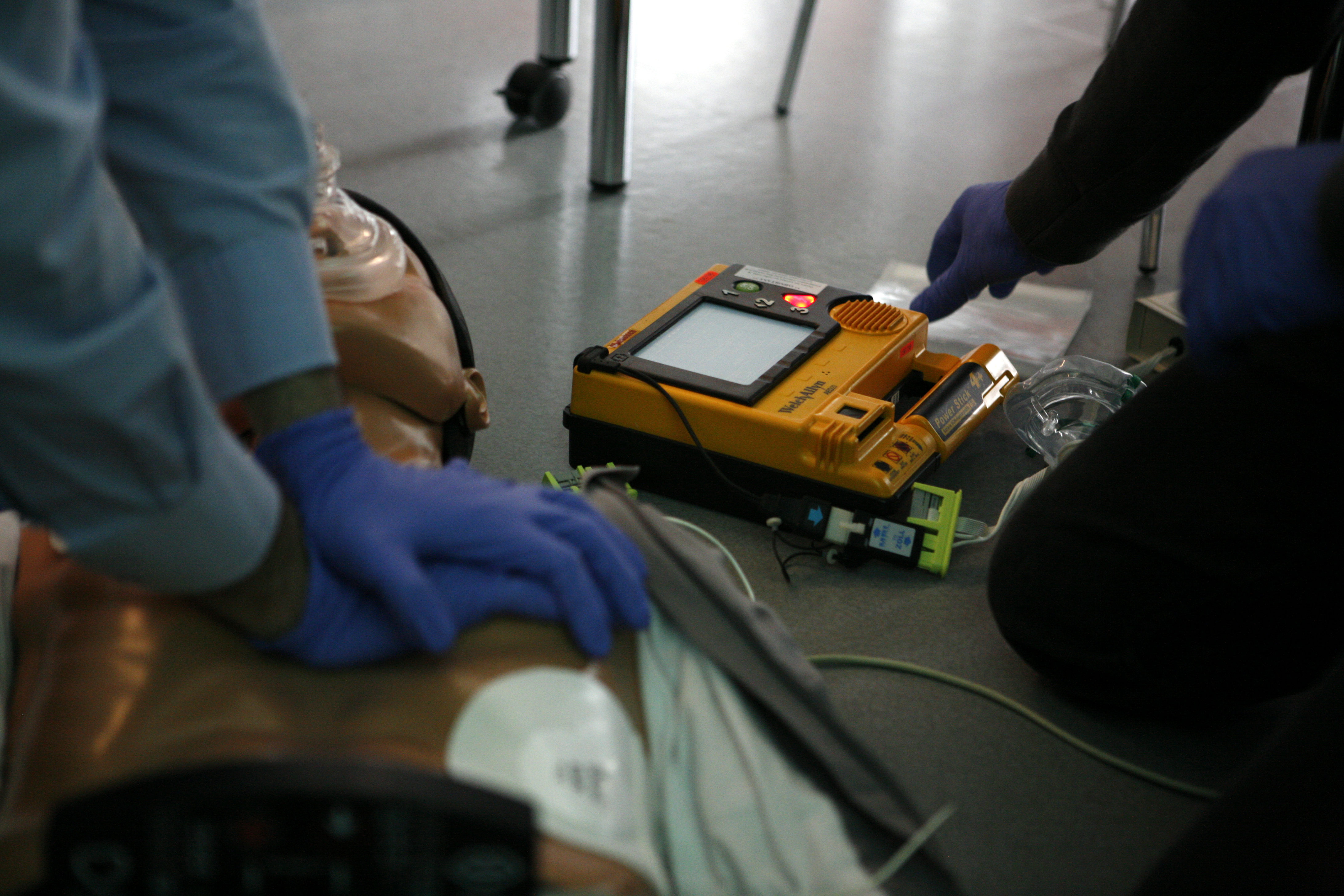|
Crash Cart
A crash cart, code cart, crash trolley or "MAX cart" is a set of trays/drawers/shelves on wheels used in hospitals for transportation and dispensing of emergency medication/equipment at site of medical/surgical emergency for life support protocols ( ACLS/ALS) to potentially save someone's life. The cart carries instruments for cardiopulmonary resuscitation and other medical supplies while also functioning as a support litter for the patient. The crash cart was originally designed and patented by ECRI Institute founder, Joel J. Nobel, M.D., while a surgical resident at Philadelphia's Pennsylvania Hospital in 1965. MAX helped enhance hospital's efficiency in emergencies by enabling doctors and nurses to save time, thereby increasing the chances of saving a life. The contents and organization of a crash cart vary from hospital to hospital, country to country, and specialty to specialty, but typically contain the tools and drugs needed to treat a person in or near cardiac arrest ... [...More Info...] [...Related Items...] OR: [Wikipedia] [Google] [Baidu] |
Dextrose
Glucose is a sugar with the molecular formula , which is often abbreviated as Glc. It is overall the most abundant monosaccharide, a subcategory of carbohydrates. It is mainly made by plants and most algae during photosynthesis from water and carbon dioxide, using energy from sunlight. It is used by plants to make cellulose, the most abundant carbohydrate in the world, for use in cell walls, and by all living organisms to make adenosine triphosphate (ATP), which is used by the cell as energy. In energy metabolism, glucose is the most important source of energy in all organisms. Glucose for metabolism is stored as a polymer, in plants mainly as amylose and amylopectin, and in animals as glycogen. Glucose circulates in the blood of animals as blood sugar. The naturally occurring form is -glucose, while its stereoisomer -glucose is produced synthetically in comparatively small amounts and is less biologically active. Glucose is a monosaccharide containing six carbon atoms ... [...More Info...] [...Related Items...] OR: [Wikipedia] [Google] [Baidu] |
Intercom
An intercom, also called an intercommunication device, intercommunicator, or interphone, is a stand-alone voice communications system for use within a building, small collection of buildings or portably within a small coverage area, which functions independently of the public telephone network. Intercoms are generally mounted permanently in buildings and vehicles, but can also be detachable and portable. Intercoms can incorporate connections to public address loudspeaker systems, walkie talkies, telephones, and other intercom systems. Some intercom systems incorporate control of devices such as signal lights and door latches. Intercoms are used on a wide variety of properties; from houses that only require one connection between a resident and the property's entrance to multi-unit apartments that require intercom hardware to be installed in every individual apartment. Some are equipped with video and its wiring (electrical installation) can be connected to the outside with a ... [...More Info...] [...Related Items...] OR: [Wikipedia] [Google] [Baidu] |
Cardiopulmonary Resuscitation
Cardiopulmonary resuscitation (CPR) is an emergency procedure used during Cardiac arrest, cardiac or Respiratory arrest, respiratory arrest that involves chest compressions, often combined with artificial ventilation, to preserve brain function and maintain circulation until spontaneous breathing and heartbeat can be restored. It is indication (medicine), recommended for those who are unresponsive with no breathing or abnormal breathing, for example, agonal respirations. CPR involves chest compressions for adults between and deep and at a rate of at least 100 to 120 per minute. The rescuer may also provide artificial ventilation by either exhaling air into the subject's mouth or nose (mouth-to-mouth resuscitation) or using a device that pushes air into the subject's lungs (mechanical ventilation). Current recommendations emphasize early and high-quality chest compressions over artificial ventilation; a simplified CPR method involving only chest compressions is recommended for ... [...More Info...] [...Related Items...] OR: [Wikipedia] [Google] [Baidu] |
Metronome
A metronome () is a device that produces an audible click or other sound at a uniform interval that can be set by the user, typically in beats per minute (BPM). Metronomes may also include synchronized visual motion, such as a swinging pendulum or a blinking light. Musicians—and others including dancers, athletes, and health professionals—often practise with a metronome to improve their timing, especially the ability to maintain a steady tempo with a regular beat or pulse. Composers and conductors often use numerical metronome markings to communicate their preferred tempos to musicians preparing for a performance. A type of metronome was among the inventions of Andalusian polymath Abbas ibn Firnas (810–887). In 1815, German inventor Johann Maelzel patented a mechanical, wind-up metronome as a tool for musicians, under the title "Instrument/Machine for the Improvement of all Musical Performance, called Metronome". In the 20th century, electronic metronomes and software ... [...More Info...] [...Related Items...] OR: [Wikipedia] [Google] [Baidu] |
Intubation
Intubation (sometimes entubation) is a medical procedure involving the insertion of a tube into the body. Most commonly, intubation refers to tracheal intubation, a procedure during which an endotracheal tube is inserted into the trachea to support patient ventilation. Other examples of intubation include balloon tamponade using a Sengstaken–Blakemore tube (a tube into the gastrointestinal tract), urinary catheterization, and nasogastric intubation using a feeding tube. Types of Intubation and Their Indications Tracheal Intubation Tracheal intubation is a procedure involving the placement of an endotracheal tube into a patient’s windpipe, also known as the trachea. This procedure may be done to treat either emergent or non-emergent conditions. Examples of emergent conditions include airway compromise, respiratory failure, allergic reactions, and trauma. An example of a non-emergent condition where tracheal intubation is performed includes surgery, during which an indi ... [...More Info...] [...Related Items...] OR: [Wikipedia] [Google] [Baidu] |
Endotracheal Tube
A tracheal tube is a catheter that is inserted into the trachea for the primary purpose of establishing and maintaining a patent airway and to ensure the adequate exchange of oxygen and carbon dioxide. Many different types of tracheal tubes are available, suited for different specific applications: * An endotracheal tube is a specific type of tracheal tube that is nearly always inserted through the mouth (orotracheal) or nose (nasotracheal). * A tracheostomy tube is another type of tracheal tube; this curved metal or plastic tube may be inserted into a tracheostomy stoma (following a tracheotomy) to maintain a patent lumen. * A tracheal button is a rigid plastic cannula about in length that can be placed into the tracheostomy after removal of a tracheostomy tube to maintain patency of the lumen. History Portex Medical (England and France) produced the first cuff-less plastic 'Ivory' endotracheal tubes. Ivan Magill later added a cuff (these were glued on by hand to make the famo ... [...More Info...] [...Related Items...] OR: [Wikipedia] [Google] [Baidu] |
Midazolam
Midazolam, sold under the brand name Versed among others, is a benzodiazepine medication used for anesthesia, premedication before surgical anesthesia, and procedural sedation, and to treat psychomotor agitation, severe agitation. It induces sleepiness, decreases anxiety, and causes anterograde amnesia. The drug does not cause an individual to become unconscious, merely to be sedated. It is also useful for the treatment of prolonged (lasting over five minutes) seizures. Midazolam can be given Oral administration, by mouth, intravenously, by Intramuscular injection, injection into a muscle, by spraying into the intranasal, nose, or through the buccal administration, cheek. When given intravenously, it typically begins working within five minutes; when injected into a muscle, it can take fifteen minutes to begin working; when taken orally, it can take 10–20 minutes to begin working. Side effects can include a decrease in efforts to breathe, hypotension, low blood press ... [...More Info...] [...Related Items...] OR: [Wikipedia] [Google] [Baidu] |
Propofol
Propofol is the active component of an intravenous anesthetic formulation used for induction and maintenance of general anesthesia. It is chemically termed 2,6-diisopropylphenol. The formulation was approved under the brand name Diprivan. Numerous generic versions have since been released. Intravenous administration is used to induce unconsciousness after which anesthesia may be maintained using a combination of medications. It is manufactured as part of a sterile injectable emulsion formulation using soybean oil and lecithin, giving it a white milky coloration. Recovery from propofol-induced anesthesia is generally rapid and associated with less frequent side effects (e.g., drowsiness, nausea, vomiting) compared to other anesthetic agents. Propofol may be used prior to diagnostic procedures requiring anesthesia, in the management of refractory status epilepticus, and for induction or maintenance of anesthesia prior to and during surgeries. It may be administered as a bolus ... [...More Info...] [...Related Items...] OR: [Wikipedia] [Google] [Baidu] |
Etomidate
Etomidate (United States Adopted Name, USAN, International Nonproprietary Name, INN, British Approved Name, BAN; marketed as Amidate) is a short-acting intravenous anaesthetic agent used for the induction of general anaesthesia and sedation for short procedures such as reduction of dislocated joints, tracheal intubation, cardioversion and electroconvulsive therapy. It was developed at Janssen Pharmaceutica in 1964 and was introduced as an intravenous agent in 1972 in Europe and in 1983 in the United States. The most common side effects include venous pain on injection and skeletal muscle movements. Medical uses Sedation and anesthesia In emergency settings, etomidate can be used as a sedative hypnotic agent. It is used for conscious sedation and as a part of a rapid sequence induction to induce anaesthesia. It is used as an anaesthetic agent since it has a rapid onset of action and a safe cardiovascular risk profile, and therefore is less likely to cause a significant drop in b ... [...More Info...] [...Related Items...] OR: [Wikipedia] [Google] [Baidu] |
Sedative
A sedative or tranquilliser is a substance that induces sedation by reducing irritability or Psychomotor agitation, excitement. They are central nervous system (CNS) Depressant, depressants and interact with brain activity, causing its deceleration. Various kinds of sedatives can be distinguished, but the majority of them affect the neurotransmitter Gamma-Aminobutyric acid, gamma-aminobutyric acid (GABA). Most sedatives produce relaxing effects by increasing GABA activity. This group is related to hypnotics. The term ''sedative'' describes drugs that serve to calm or Anxiolytic, relieve anxiety, whereas the term ''hypnotic'' describes drugs whose main purpose is to initiate, sustain, or lengthen sleep. Because these two functions frequently overlap, and because drugs in this class generally produce dose-dependent effects (ranging from anxiolysis to loss of consciousness), they are often referred to collectively as ''sedative–hypnotic'' drugs. Terminology There is some overlap ... [...More Info...] [...Related Items...] OR: [Wikipedia] [Google] [Baidu] |
Paralytic
Paralysis (: paralyses; also known as plegia) is a loss of motor function in one or more muscles. Paralysis can also be accompanied by a loss of feeling (sensory loss) in the affected area if there is sensory damage. In the United States, roughly 1 in 50 people have been diagnosed with some form of permanent or transient paralysis. The word "paralysis" derives from the Greek παράλυσις, meaning "disabling of the nerves" from παρά (''para'') meaning "beside, by" and λύσις (''lysis'') meaning "making loose". A paralysis accompanied by involuntary tremors is usually called " palsy". Causes Paralysis is most often caused by damage in the nervous system, especially the spinal cord. Other major causes are stroke, trauma with nerve injury, poliomyelitis, cerebral palsy, peripheral neuropathy, Parkinson's disease, ALS, botulism, spina bifida, multiple sclerosis and Guillain–Barré syndrome. Incidents that can cause such damage include slip and fall acciden ... [...More Info...] [...Related Items...] OR: [Wikipedia] [Google] [Baidu] |






